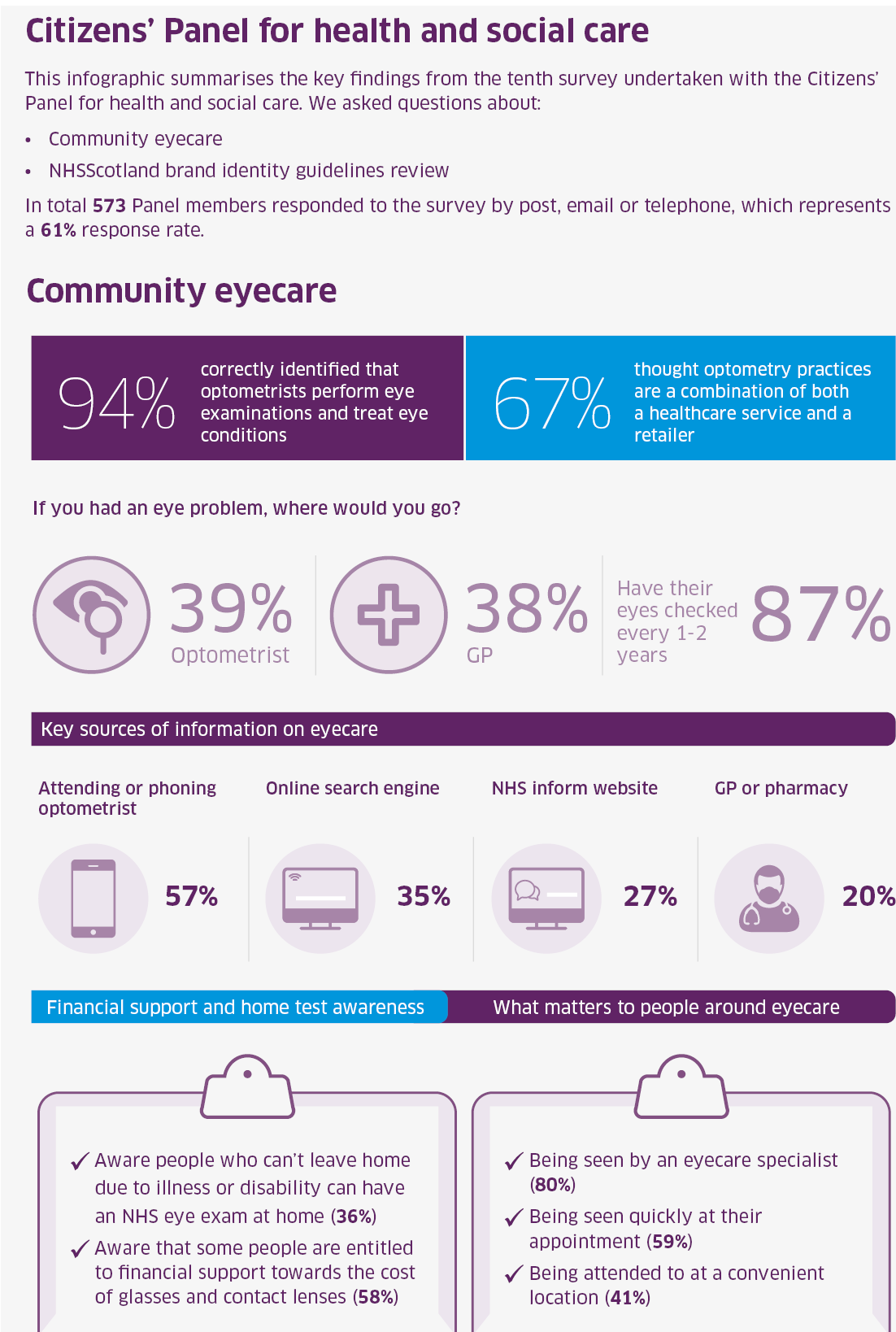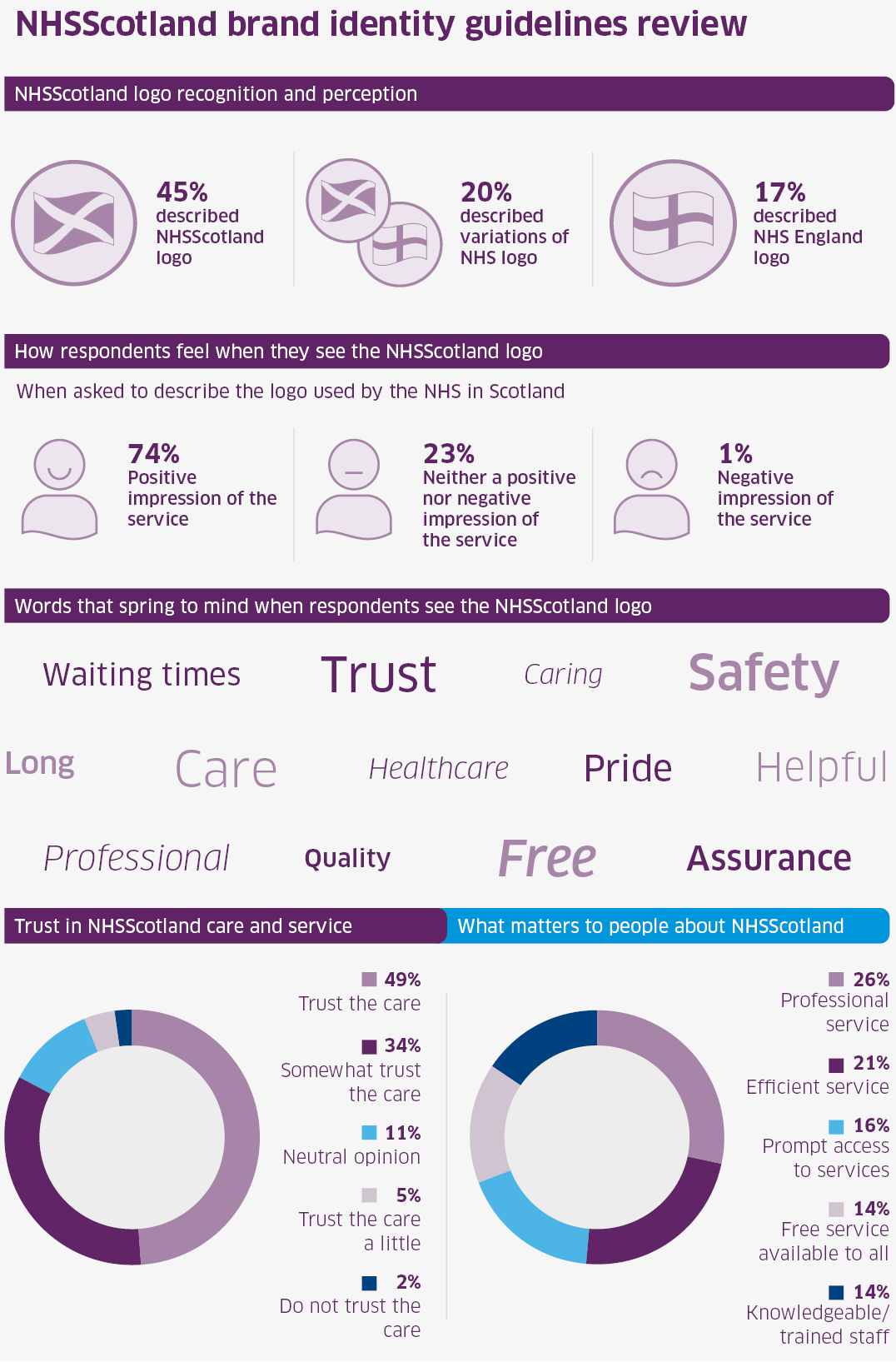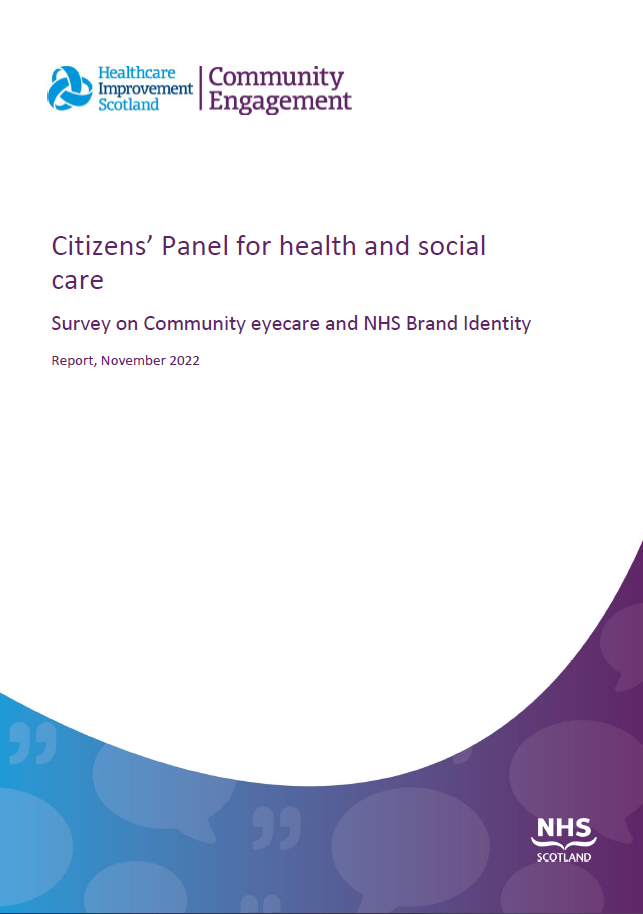The tenth Citizens' Panel survey was carried out between June and August 2022. We asked questions about community eyecare and NHS Scotland brand identity guidelines review
At the time of this survey in mid 2022, there were 941 Panel members from across all 32 local authority areas.
A total of 573 responses (61% response rate) were received, either by post, email or by telephone. This level of return provides data accurate to +/-4.03% at the overall Panel level. In this report we do not break the results down into subcategories (for example, gender or age) as they are not statistically significant. All comparisons that are made in this report are statistically significant, unless otherwise stated.
Key findings
Community eyecare

The majority of survey respondents wear glasses and/or contact lenses sometimes or always (85%). Just 15% of respondents do not wear either glasses or contact lenses. This is aligned with what the General Optical Council found in 2022, with 81% of people in Scotland wearing glasses or contact lenses, and findings from the College of Optometrists in 2013 that 74% of people across the UK wear corrective eyewear or have had laser eye surgery.
When asked to consider the role of an optometrist and optometry practices, 94% said they believe an optometrist performs eye examinations and treats eye conditions and 67% thought optometry practices (opticians) were a combination of both a healthcare service and a retailer.
If they had an eye problem respondents said that they would either go to an optometry practice (39%) or a GP practice (38%). The key reason for choosing to go to either of these was that they would be able to diagnose and treat these kinds of problems (77% for GP practice and 91% for optometry practice).
Almost nine in ten respondents (87%) said they have their eyes examined every 1 to 2 years. For those who have their eyes examined less than every 1 to 2 years the main reason given for this was that ‘I don’t think I need it as I don’t have a problem with my vision’ (50%).
Over half of respondents (58%) were aware that some people are entitled to financial support towards the cost of glasses and contact lenses. A further 29% said they were aware but were unsure who is eligible and/or didn’t know how to organise. Just 13% said that they were not aware of the financial support available to help some people toward the cost of glasses and contact lenses.
Just over one third of respondents (36%) said that they were aware that some people who can’t leave their home unaccompanied because of a physical or mental illness or disability are entitled to a free NHS-funded eye examination at home. 7% were aware but didn’t know who is eligible and/or how to organise this and 57% were not aware of this.
Key sources of information relating to eye health and eyecare services in Scotland were from the optometry practice either by attending or phoning (57%), Google or another online search engine (35%), the NHS Inform website (27%) or from their GP or Pharmacy practice (20%).
Respondents’ top priorities for getting the eyecare that they need were being seen by an eyecare specialist (80%), being seen quickly (59%) and convenient location (41%).
Recommendations
Recommendation 1: We recommend Scottish Government continues to work towards increasing awareness around the healthcare service aspect of optometry services, and its separation from retail aspects of opticians e.g. no expectation of users to use the same optometry service for purchase of eyecare products.
Recommendation 2: We recommend Scottish Government continues to work towards prioritising first port of call messaging around optometry regarding all eyecare concerns and not only vision, to assist patients in getting the right care at the right place, and to reduce pressure on GP practices. The campaign should highlight public priorities: how optometry services ensure individuals are seen by a specialist, quicker and at a convenient location. Continue to communicate clear guidance to GP practices that individuals should, at a first instance, be signposted and referred to optometry services for all eyecare concerns.
Recommendation 3: We recommend Scottish Government continues to work towards increasing awareness on the importance of having a regular eye examination and benefits that go beyond one’s vision, especially within groups or individuals that may think they don’t need them due to not currently having vision issues.
Recommendation 4: We recommend Scottish Government continues to work towards increased awareness of financial support towards the cost of glasses and contact lenses, with clear information available to the public around who is eligible and how to organise this. Liaise with optometry practices to ensure this reaches those who may need it the most.
Recommendation 5: We recommend Scottish Government continues to work towards increasing awareness of the provision/entitlement to free NHS-funded examination at home for those who can’t leave their home unaccompanied. This should focus both on specific user groups that may need to access this service, as well as the general public who may need to know this in the future or for others they care for. Liaise with optometry practices to ensure this reaches those who may need it the most.
Recommendation 6: We recommend Scottish Government continues to work on NHS Inform being the first point of call for digital access to eyecare information, ensuring this is also reflected when using Google or other digital search engines to find information around eyecare.
NHSScotland brand identity guidelines review

Panel members were asked to describe the logo used by the National Health Service in Scotland (or NHS Scotland as it is known) with a view to helping improve understanding about awareness, attitudes and perceptions around NHS Scotland. Almost half of respondents were able to correctly describe the NHS Scotland logo (45%). One in five (20%) could describe a logo that was identifiably the NHS logo but not specific to NHS Scotland and 17% described a logo that was NHS England.
When respondents see the NHS Scotland logo, the majority (74%) said they feel it gives them a positive impression of the service provided. 23% said that it gives them neither positive nor negative impression and just 1% said it gave them a negative impression. When asked what words or phrases best describe what they feel most strongly when they see the NHS Scotland logo, the most commonly used words included: “safety”, “helpful”, “professional”, “care”, “trust”, “assurance” and “free”.
Almost half of respondents (49%) said they very much trust the care and service that NHS Scotland provides, 34% said they trust them somewhat, 11% had a neutral opinion, 5% said they trusted them a little and 2% did not trust the care and service provided by NHS Scotland at all. This was mostly informed by respondents’ positive experience of NHS Scotland or good treatment provided.
Receiving a professional (26%) and quick/efficient (21%) service was what matters most to respondents about the care and service they receive from NHS Scotland. This was followed by having prompt access to services (16%), free service available to all (14%) and knowledgeable/trained staff (14%).
Recommendations
Recommendation 1: We recommend Scottish Government continues to work on increasing awareness of NHS Scotland brand identity to continue to effectively signpost patients and the public to quality NHS services in Scotland.
Recommendation 2: We recommend Scottish Government continues to work towards improving awareness of NHS Scotland brand identity use in those services with lower recognition, such as NHS dentists (66%), pharmacies (60%) and opticians (47%).
Recommendation 3: We recommend Scottish Government uses this information as part of Recommendation 2 to support and encourage services where there is lower brand recognition, such as dentists, pharmacies and opticians providing NHS Scotland-funded services to use the NHS Scotland brand identity more often.
Recommendation 4: We recommend Scottish Government considers further work around exploring key concerns the public may have for the NHS in the future and gain a deeper understanding about them and what can be done to sustain public trust in NHS Scotland and the service and care provided.
Impact
Community eye care
Feedback from Scottish Government’s Community Eye Care Policy Team 6 months after published.
The findings have had a positive impact on our work and informed a new community eye care patient information leaflet. This is being printed and distributed to all community optometry practices in Scotland. A copy is available here:
https://www.eyes.scot/media/1480/your-guide-to-free-nhs-eye-examinations-in-scotland.pdf
Before the Citizens' Panel eye care survey there was no Scotland specific data on the subject and we found the results helpful. We used all 6 recommendations in the report to inform the leaflet.
We hope the impact of the leaflet will increase awareness of eye health and care services in Scotland. We will continue to use the findings to inform our future eye health awareness raising work.
NHS Branding Guidelines
Feedback from Scottish Government Communications Team
The Citizens’ Panel findings have helped us gain insight how the NHSScotland brand identity is measured and understood. Findings have been shared within Scottish Government including the Cabinet Secretary for Health and Social Care.
They will help inform NHSScotland brand policy to increase awareness of NHS Scotland brand identity. This will continue to effectively signpost patients and the public to quality NHS services in Scotland.

